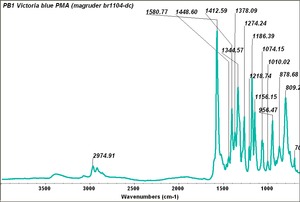Difference between revisions of "Victoria blue"
m (Text replace - "== Authority ==" to "== Sources Checked for Data in Record ==") |
|||
| Line 12: | Line 12: | ||
Basic Blue 26; CI 44045; Pigment Blue 2; Basic Blue 7; CI 42595; Basic Blue 11; CI 44040; Pigment Blue 10; Fast Blue | Basic Blue 26; CI 44045; Pigment Blue 2; Basic Blue 7; CI 42595; Basic Blue 11; CI 44040; Pigment Blue 10; Fast Blue | ||
| + | |||
| + | [[[SliderGallery rightalign|PB1 Victoria blue PMA (magruder br1104-dc).TIF~FTIR (MFA)]]] | ||
== Other Properties == | == Other Properties == | ||
Revision as of 11:08, 25 February 2020
Description
A commercial product name for a series of organic blue dyes. Victoria blues were originally made from aniline dyes in the early 20th century, but formulations have changed over the years. Currently, Victoria blue colors are used to dye silk, wool, cotton, juste, paper, inks, wood stains, crayons, and soaps. They are also used as a biological stain. Examples of currently available products are:
- Victoria blue R - Basic Blue 11, CI 44040; CAS 2185-86-6; Pigment Blue 10
- Victoria pure blue B - Basic Blue 7; CI 42595
- Victoria blue B - Basic Blue 26; CI 44045; CAS 2580-56-5; Pigment Blue 2
Synonyms and Related Terms
Basic Blue 26; CI 44045; Pigment Blue 2; Basic Blue 7; CI 42595; Basic Blue 11; CI 44040; Pigment Blue 10; Fast Blue
Other Properties
Soluble in hot water, ethanol, ether.
| Composition | C33H31N3 - HCl (acid dye) |
|---|
Sources Checked for Data in Record
- Richard S. Lewis, Hawley's Condensed Chemical Dictionary, Van Nostrand Reinhold, New York, 10th ed., 1993
- Monona Rossol, The Artist's Complete Health and Safety Guide, Allworth Press, New York, 1994
- Colour Index International online at www.colour-index.org
